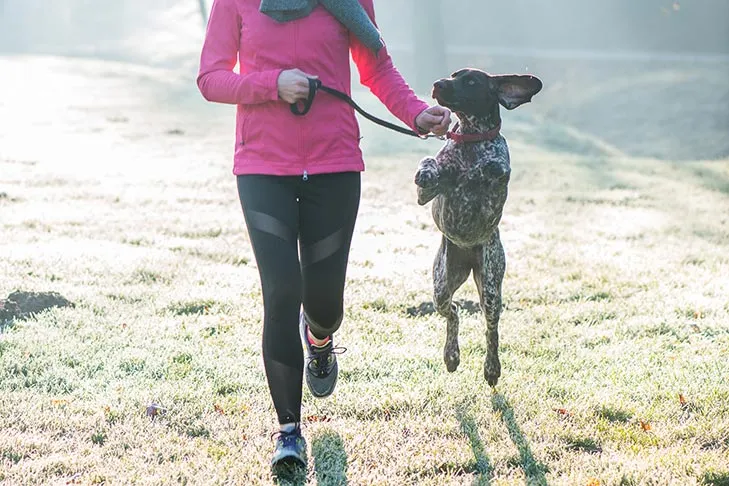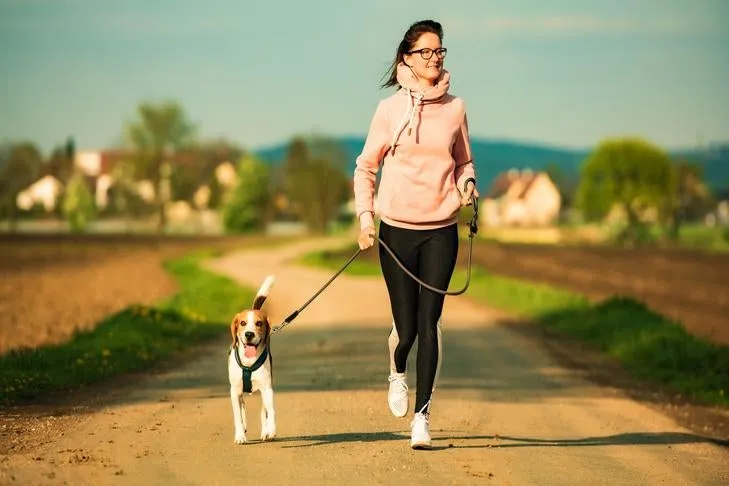Running with your dog offers a fantastic way to strengthen your bond, keep both of you physically fit, and inject excitement into your routine. Canine fitness is a crucial component of overall health and well-being, and having a consistent running partner can be an invaluable source of motivation for both human and hound. This comprehensive guide will walk you through How To Train Your Dog To Run Alongside You, transforming your furry friend into the ideal running companion, while ensuring their safety and enjoyment every step of the way.
Before You Start: Essential Considerations
Before lacing up your shoes and hitting the pavement with your canine, it’s vital to ensure they are physically and temperamentally suited for the activity. Proper preparation is the first step in successful dog training.
Is Your Dog Ready? Breed and Age
Not all dogs are built for long-distance running. Breeds like Greyhounds, Pointers, and Huskies often excel, while brachycephalic (short-nosed) breeds such as Pugs or Bulldogs may struggle due to breathing difficulties. Additionally, running is generally not safe for puppies. Their bones and growth plates are still developing, and high-impact activities can cause permanent damage. For most breeds, it’s best to wait until your dog is at least 18 months old before starting a running program. Some larger breeds might require even more time to fully mature.
Veterinary Check-up
Even if your dog’s breed and age seem appropriate, a visit to the veterinarian for a thorough physical check-up is non-negotiable. Your vet can assess their overall health, joint condition, cardiovascular fitness, and identify any underlying issues that could make running unsafe. They can also provide personalized advice based on your dog’s specific needs and health history.
Laying the Foundation: Mastering Leash Manners
The cornerstone of running alongside your dog successfully is impeccable leash manners. A dog that pulls, lunges, or weaves dangerously on a walk will be even more challenging and potentially hazardous at faster speeds.
The Importance of Loose-Leash Walking
Your dog must master loose-leash walking before you even consider jogging. This means they should walk calmly by your side, with the leash hanging in a relaxed “J” shape, without pulling. Remember that the world is full of exciting distractions—squirrels, intriguing smells, other dogs. To keep your dog’s attention on you and reinforce the desired behavior, you need to be equally rewarding. Use high-value treats, their favorite toys, and enthusiastic verbal praise to reward them whenever the leash remains slack. Consistency is key here; every time your dog walks politely, acknowledge and reward it. If your puppy tends to grab or stop your puppy from biting the leash during walks, address this behavior firmly and consistently before progressing to running.
Consistent Side Positioning
When you begin running together, it’s essential for your dog to stay on one side of you. If they run in front, lag behind, or crisscross your path, it creates a tripping hazard for you and can tangle the leash. Choose a side—left or right—and stick with it. It doesn’t matter which you pick, as long as you’re consistent.
Start by practicing at a walking pace. Always give your dog treats and praise in the exact position you want to reinforce. For instance, if you want them on your left, only offer rewards when they are at your left hip. This clear communication helps your dog understand precisely what behavior earns the reward. Once they reliably stay on one side, you can teach them to switch to the other side with a distinct cue if you wish, though many runners find sticking to one side easier. For added comfort and safety, especially as you increase speed, consider using a hands-free dog leash. If you’re struggling to get your dog to stop biting during excited moments, this foundational training will also help redirect their energy.
 German Shorthaired Pointer jogging happily alongside its owner on a trail, demonstrating proper side-by-side running technique.
German Shorthaired Pointer jogging happily alongside its owner on a trail, demonstrating proper side-by-side running technique.
Introducing Speed Cues
Once your dog reliably walks politely by your side, it’s time to introduce cues that communicate changes in speed.
It’s helpful to have distinct verbal cues for different paces. For example, “let’s go” can signal it’s time to walk and move forward. A different cue, such as “get running” or “move it,” can tell your dog it’s time to pick up the pace and start jogging or running. The more specific information you provide, the better your dog will understand and respond to your expectations.
To teach the running cue, incorporate short bursts of jogging or running into your regular walks. Immediately before you accelerate, give your chosen running cue. As soon as your dog matches your pace and moves quickly to catch up by your side, reward them generously. Similarly, you can teach a slowing-down cue, like “whoa” or “easy,” by giving the command just before you decrease your speed and rewarding them when they comply.
 A powerful Rottweiler gracefully running in a park, maintaining pace with its owner during a training session.
A powerful Rottweiler gracefully running in a park, maintaining pace with its owner during a training session.
Building Stamina and Endurance
Just like humans, dogs need to build up their strength and endurance gradually. Rushing this process can lead to injury or turn your dog off running.
Start by integrating small, manageable stretches of running into your usual walks. For example, you might walk for five minutes, jog for one minute, and then return to walking. On each subsequent outing, gradually increase the duration of your running intervals and decrease the walking portions. This “walk-run” method helps your dog’s muscles, joints, and cardiovascular system adapt without undue stress. Over several weeks, your dog will steadily build the stamina required to comfortably run longer distances alongside you. Pay close attention to their breathing and gait, ensuring they are not struggling.
Ensuring a Safe and Enjoyable Run
With your dog now trained and conditioned to be your running companion, remember these vital tips to ensure every run is safe, comfortable, and fun for both of you:
- Warm-up and Cool-down: Always begin your runs with several minutes of brisk walking to warm up your dog’s muscles, and end with a similar cool-down period.
- Weather Watch: Dogs are more susceptible to heatstroke than humans. Avoid running during the hottest parts of the day or in high humidity. In cold weather, short-haired dogs might need a jacket, and paw protection can be beneficial on icy or very hot surfaces.
- Hydration is Key: Always carry water for both yourself and your dog, offering them regular breaks to drink, especially on longer runs.
- Frequent Breaks: Allow your dog opportunities to sniff, recharge, and relieve themselves. These breaks are crucial for their mental stimulation and physical comfort.
- Off-Leash Considerations: Only allow your dog to walk a dog off leash in areas where it is safe, legal, and if they have a rock-solid recall amidst distractions. Even the best-behaved dogs can be tempted by wildlife. Ensure their training your puppy to come is impeccable before attempting off-leash activities.
- Read Their Signals: Your dog may try to please you even when exhausted. Watch for signs like excessive panting, lagging behind, limping, or seeking shade. If you notice any of these, it’s time to stop and rest.
 A cheerful Beagle on a leash, running smoothly alongside its owner on a scenic trail, illustrating effective dog running companionship.
A cheerful Beagle on a leash, running smoothly alongside its owner on a scenic trail, illustrating effective dog running companionship.
Indoor Alternatives for Extreme Weather
Even dedicated runners face days when the weather makes outdoor running with your dog unsafe. Extreme heat, freezing temperatures, or heavy storms mean it’s time for indoor exercise.
You can still maintain your dog’s physical conditioning with various indoor activities. Depending on your dog’s size, a spirited game of fetch down a long hallway or controlled runs up and down carpeted stairs can elevate their heart rate and work their muscles. Setting up a simple obstacle course using household items like hula hoops or cardboard boxes can also provide mental and physical stimulation. Many local training facilities offer indoor agility classes or doggy daycare with supervised play, which are excellent ways to keep your dog active.
For a more structured indoor workout, many dogs can be trained to use a treadmill. While specialized dog treadmills exist, a human treadmill can work if it’s long enough for your dog’s stride. However, simply putting your dog on a treadmill is not enough. Research proper treadmill training techniques or consult a professional dog trainer to ensure your dog enjoys the machine and uses it safely. Critically, never tie your dog to the treadmill or leave them unsupervised while it’s in operation.
Conclusion
Successfully training your dog to run alongside you is a rewarding journey that deepens your bond and boosts both your fitness levels. By starting with essential preparations like vet checks and loose-leash training, gradually introducing speed cues, building endurance, and prioritizing safety, you’ll create a harmonious and fulfilling running partnership. Remember to listen to your dog, adapt to their needs, and make every run an enjoyable experience. With patience and consistent positive reinforcement, you and your canine companion will be enjoying many miles together. For more expert tips on dog training and care, explore other resources at Dog Care Story.
